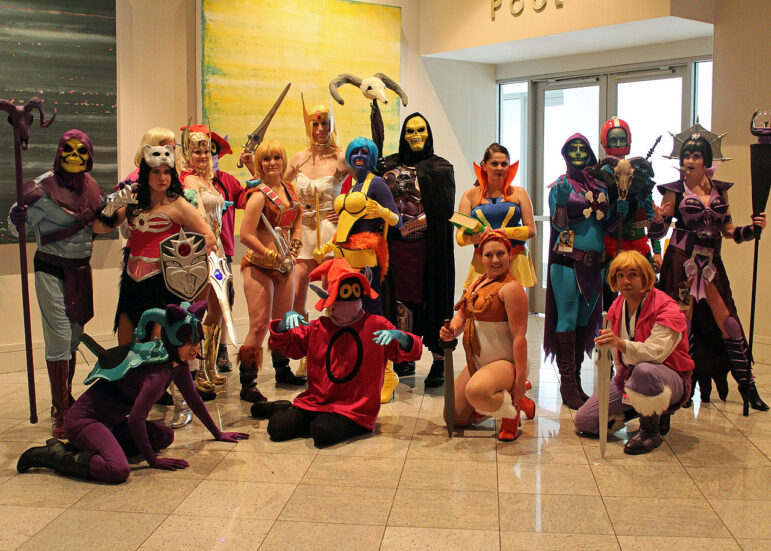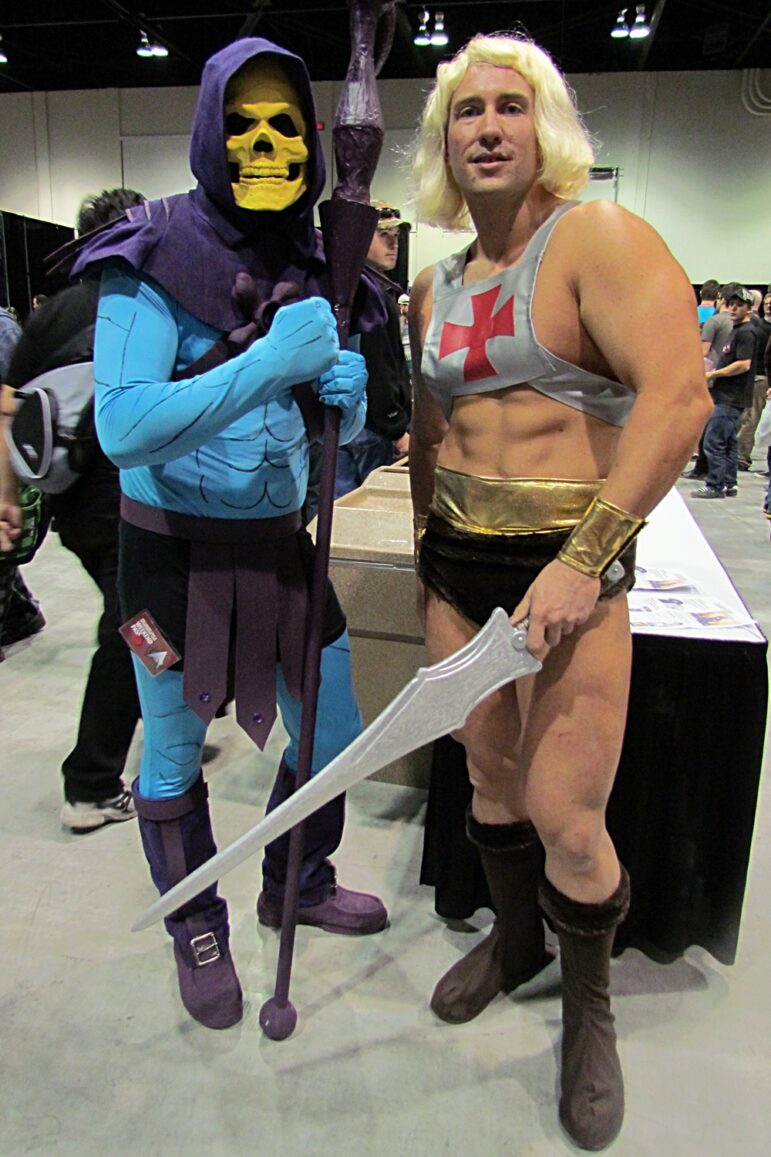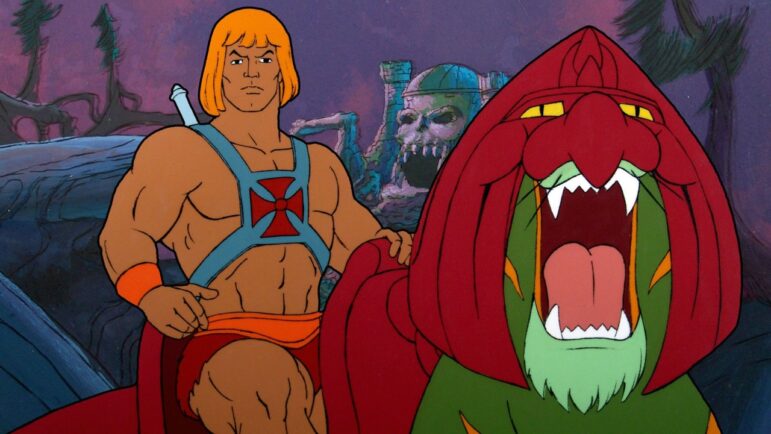
He-Man and the Masters of the Universe (MOTU) may have begun as a 1980s cartoon created to sell action figures, but its blend of ancient mythology, occult symbolism, and cosmic battles left a lasting impression far beyond its commercial intent.
The series’s iconic battle cry, “By the power of Grayskull, I have the power!” became more than a catchphrase for its fans — it spoke to a deeper yearning for personal transformation, inner strength, and mastery over hidden forces. Through its visual and narrative elements, He-Man tapped into powerful archetypes and mystical symbols that resonate with timeless themes of magic, self-realization, and the battle between light and shadow.

Cosplayers portraying characters from He-Man and the Masters of the Universe at the 2014 DragonCon [Ryan Quick, Wikimedia Commons, CC 2.0]
The Sword of Power: An Icon of Magical Transformation
At the heart of He-Man is the transformation of Prince Adam into the mighty He-Man, a process activated by his invocation of the mystical Sword of Power. This iconic moment is much more than a simple costume change — it reflects a profound symbolic transformation deeply rooted in magical traditions.
The Sword of Power is not just a weapon; it represents the conduit through which Adam channels divine energy to transcend his ordinary self. In many magical traditions, the use of talismans, wands, and swords serves a similar purpose, acting as physical manifestations of spiritual tools. These objects act as intermediaries between the practitioner and the mystical forces they seek to access, allowing them to tap into greater power.
In both fiction and esoteric traditions, swords have long been potent symbols. They are often associated with intellect, willpower, and the ability to cut through illusion and falsehoods. This symbolism can be found in mythological tales, from King Arthur’s Excalibur to the magical swords of Norse and Eastern traditions, each representing more than just physical strength. These swords often serve as symbols of authority, the mind’s sharpness, and the bearer’s ability to discern truth.
Similarly, in He-Man, the Sword of Power represents Prince Adam’s potential to rise above his limitations and harness his true essence—just as many magical systems use symbols to channel greater truths and inner power.
Much like ceremonial magic, where ritual tools such as swords embody the practitioner’s control over the mind and spirit, He-Man’s sword does more than grant him physical power — it bestows wisdom and responsibility. In magical practices, the sword is often used to focus and direct energy, to carve out a sacred space, or to draw boundaries between the mundane and the magical. He-Man’s invocation of “the power” is akin to this ritual act, as he channels the cosmic forces that reside within Castle Grayskull and aligns them with his own will.
His transformation isn’t simply about gaining strength for battle; it’s a moment of claiming his role as protector of his land, Eternia, a symbol of the sacred responsibility that comes with wielding such power.
This invocation of power in He-Man echoes a central tenet of many esoteric traditions: the belief in personal sovereignty and the ability to harness universal energies through one’s own will. Magic is not about external manipulation but about internal mastery and alignment with larger cosmic forces. Dion Fortune, the influential occultist, emphasized that “Magic is the art of changing consciousness at will.” He-Man’s transformation from Prince Adam symbolizes this spiritual process of self-mastery, where internal change —represented by his shift in consciousness and self-identity — leads to the manifestation of external power.
The sword, therefore, is more than a weapon; it is the key to unlocking the potential within, reflecting the idea that true magic happens when individuals connect with their own inner strength and the universal forces surrounding them.
Castle Grayskull: The Seat of Hidden Knowledge
Castle Grayskull, with its foreboding, skull-like façade and mysterious depths, represents the esoteric seat of ancient wisdom. It evokes symbols of death and rebirth, central themes in both occult traditions and mythology. In many magical systems, such as Hermeticism and mysticism, wisdom is often portrayed as guarded knowledge, only accessible to those who prove themselves worthy.
Castle Grayskull’s ominous design and powerful secrets mirror the concept of the Akashic Records or Hermetic wisdom — hidden knowledge accessible only through spiritual initiation. The castle, with its deep connection to ancient powers, serves as the locus of mystical knowledge that drives He-Man’s powers. In the same way, the pursuit of hidden wisdom is central to many magical traditions.
As Israel Regardie once said, “The most important factor in any form of magic is the source of power from which the operator draws his or her inspiration and energy.” Castle Grayskull is this source — an ancient well of knowledge that the characters seek to either protect or control.
He-Man and Skeletor: Light, Shadow, and Integration
The battle between He-Man and Skeletor is not just a simple struggle of good versus evil, but a deeper, symbolic representation of light versus shadow. Skeletor, with his skeletal appearance, represents darker impulses — ambition, ego, and the lust for power. His obsession with capturing Castle Grayskull and its power reflects the danger of seeking knowledge for selfish ends, without regard for cosmic balance.

Skeletor and He-Man cosplayers at Calgary Comic and Entertainment Expo, 2012 [5of7, Flickr, CC 2.0]
In contrast, He-Man stands as the figure of balance and harmony. His power comes from attuning himself to ancient forces rather than seeking to control them. This reflects the magical principle that true power lies in harmonizing with greater forces rather than attempting to dominate them. He-Man’s struggle against Skeletor can be seen as a symbolic battle within the self—one between light and shadow, wisdom and ego. As Carl Jung wrote, “One does not become enlightened by imagining figures of light, but by making the darkness conscious.” He-Man’s story offers a reminder of the need for balance, both within and outside oneself.
The Power of Transformation
Beyond battles and adventures, one of the central themes of He-Man is transformation — embodied most clearly by Prince Adam’s metamorphosis into He-Man. This transformation can be seen as a metaphor for the spiritual journey many traditions describe, where an individual undergoes personal growth and change through connecting with divine or universal energies. He-Man’s iconic phrase “I have the power” reflects a central idea in magic: that one’s power lies in the ability to invoke and manifest their will.
In magical traditions, transformation is not simply about gaining strength but about the refinement of the self, the alignment of one’s spirit with cosmic forces, and the embodiment of higher truths. He-Man’s journey from a mild-mannered prince to the mightiest man in the universe symbolizes this process of self-initiation and the harnessing of inner power to achieve mastery over oneself and one’s environment.

He-Man and Battle-Cat, with Castle Grayskull lurking in the background [Mattel, fair use]
Although He-Man and the Masters of the Universe began as a commercial endeavor to sell toys, it has transcended that initial purpose to become a cultural touchstone with profound significance. Its lasting legacy endures because it taps into deeper, universal themes of personal power, transformation, and the eternal struggle between light and shadow — ideas that resonate across time and cultures.
The show’s iconic use of archetypal symbols—such as the Sword of Power, Castle Grayskull, and the battle between He-Man and Skeletor—echoes the timeless concepts found in myth, magic, and the occult. The Sword of Power, for example, is reminiscent of ancient magical tools that signify inner strength and the unlocking of hidden potential, while Castle Grayskull represents the pursuit of wisdom, both mystical and intellectual.
The ongoing tension between He-Man and Skeletor reflects the universal dichotomy between good and evil, light and dark, and the constant choice to rise above darker impulses in favor of virtue. This portrayal of the human condition resonates with esoteric traditions, where the hero’s journey is not only a physical battle but a spiritual and psychological evolution. He-Man’s transformation — from the seemingly ordinary Prince Adam to the mighty hero — embodies the esoteric principle of personal alchemy: the idea that through self-discipline, courage, and the embrace of inner strength, one can transcend limitations and reach a higher state of being.
As such, the show’s exploration of personal transformation, the quest for self-mastery, and the pursuit of wisdom has left a lasting impact on viewers. It serves as a reminder that true power lies not just in external feats of strength but in the cultivation of inner balance, wisdom, and the potential for continuous evolution. By weaving these ancient motifs into a modern narrative, He-Man and the Masters of the Universe continues to inspire, offering a timeless message about the enduring journey toward enlightenment and the eternal potential for transformation within us all.
The Wild Hunt is not responsible for links to external content.
To join a conversation on this post:
Visit our The Wild Hunt subreddit! Point your favorite browser to https://www.reddit.com/r/The_Wild_Hunt_News/, then click “JOIN”. Make sure to click the bell, too, to be notified of new articles posted to our subreddit.